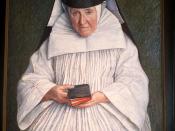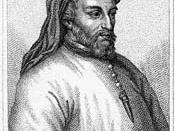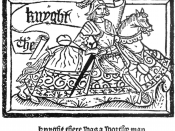The character of the Prioress in Geoffrey Chaucer's "Canterbury Tales" is a woman of two faces. She is introduced in the General Prologue as an aristocratic, genteel, pious nun, however her actions may speak louder then words.
In the reading "The Canterbury Tales" by Geoffrey Chaucer, there is a detailed description about the nun Prioress in the "General Prologue". Chaucer uses physical and spiritual relationships to show the characteristics of a person. To describe how the nun was, Chaucer writes with irony in the description of the nun Prioress, everything that Chaucer says about her means the opposite. One of the most noticeable elements of irony Chaucer uses is the Prioress' name introduced in the General Prologue "Madame Eglantine" a name that symbolizes the Virgin Mary. This naming of the Prioress by Chaucer after a flower symbolizing Mary is ironic, because Mary is the embodiment of love and mercy.
These are two things that the Prioress is suppose to represent as a nun, but does not value them much over all. This in itself is a satire on the part of Chaucer; he chose a name for his Prioress that was opposite with her actual character.
Being a nun in the Middle Ages required one to take three vows poverty, humility, and obedience. However Chaucer describes the nun with opposite traits to show us, how the she had all the characteristics that a nun should not have. She was well educated and had good manners "She spoke French well and properly after the school of Stratford-at-Bow(124-125). She also showed charitably and pity, and also a strong love for God and his creations. "She would weep if she saw mouse caught in a trap" (144-145). Chaucer connects the relationship between how she sang and with her nose. When it...


